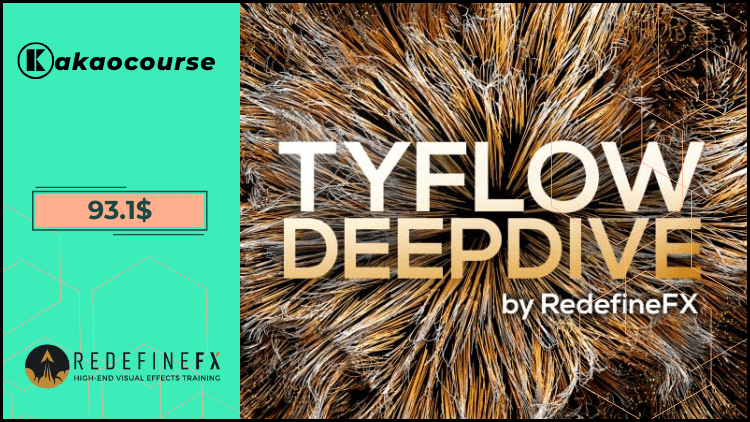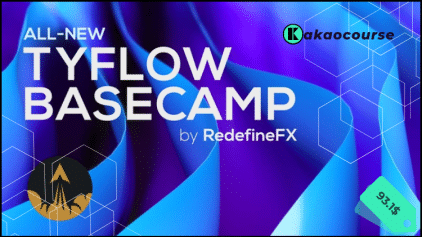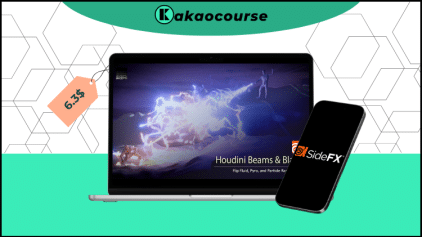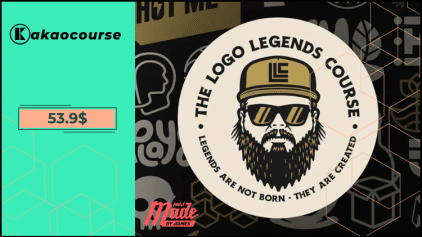Free Download tyFlow Deepdive: A 3D Simulation & Dynamic FX Course by RedefineFX
tyFlow Deepdive: A 3D Simulation & Dynamic FX Course by RedefineFX, Sneak Peek Inside The Course:
.
tyFlow Deepdive: A 3D Simulation & Dynamic FX Course by RedefineFX, Watch Our Free Video Sample to Find Out More:
Overview this course
tyFlow is one of the most flexible simulation toolsets in 3ds Max—capable of elegant motion design, robust destruction, and sophisticated character-driven crowd shots. Yet true fluency takes more than skimming menus. tyFlow Deepdive: A 3D Simulation & Dynamic FX Course by RedefineFX is a comprehensive, project-driven program that shows you how to think and build like a technical artist, so your FX are not only impressive but repeatable under real production deadlines.
Built as a natural progression beyond Basecamp, this Deepdive expands your skills with 55+ tightly structured lessons that move from principles to polished outcomes. You will explore tyActors for animated crowds and ragdolls, VDB workflows for sculpting volumes from meshes and particles, custom properties to drive behavior (e.g., color by age or speed), and Phoenix FD interactions that let fluid and smoke simulations inform particle motion. You will also go deeper on essential operators—Set Target, Branch, Resample, Point Force, new CUDA-accelerated binds, advanced cloth tearing and inflation, and much more.
The course is designed around small, focused builds that grow into complete shots. Every step emphasizes clarity: modest scene complexity, clean naming, checkpoint caching, and decisions you can explain to a client or teammate. The result is not just “cool particles,” but a toolkit for controlled, art-directable FX you can adapt to any brief.
At a glance
-
Format: 55+ lessons with downloadable project files and step-by-step demonstrations
-
Toolset: 3ds Max, tyFlow (tyMesher, tySlicer), Phoenix FD (optional), CUDA features where available
-
Focus areas: Particles & forces, cloth & binds, VDB volumes, actors & crowds, Set/Link/Move-to-target systems
-
Outcome: Portfolio-ready simulations with a professional build process you can reuse
Why should you choose this course?
-
Depth with structure. Rather than scattered tips, you get a coherent path through the major pillars of tyFlow—particles, cloth, volumes, and actors—so each concept reinforces the next.
-
Production habits from lesson one. Learn caching, display optimization, and versioning that keep heavy scenes responsive and review-friendly.
-
Art direction baked in. Techniques prioritize control: hang objects on procedural ropes, choreograph splines, time fractures, and shape cloth tearing so the shot reads instantly.
-
Coverage of the features that matter now. VDB operators for generate/subtract/morph workflows, Set Target for intelligent linking and motion control, CUDA binds for thousands of ropes and constraints, and Phoenix FD property transfers for rich, data-driven looks.
-
Actor systems made approachable. Import Mixamo characters, combine multiple animations, trigger states conditionally, and transition to PhysX ragdolls when the story demands impact.
-
Faster path to real results. With complete project files and clean setups, you can swap in a new product model or logo and iterate immediately—ideal for pitches, reels, and client work.
-
Clear explanations, no gatekeeping. Complex operators are demystified with practical metaphors, annotated flows, and side-by-side “why this works” breakdowns.
What You’ll Learn
You’ll develop both conceptual understanding and muscle memory for building robust simulations. Expect to finish with repeatable recipes, plus the confidence to improvise with intent.
1) Fundamentals that scale
-
Event logic and the “flow of decisions” (spawn → test → modify → output)
-
Display and viewport strategies for heavy scenes: particle budgets, multithreading, and caching
-
Clean hierarchy, layer management, and color-coding to keep flows readable
2) Particle relationships & smart operators
-
Parent / Sibling / Child relationships for coordinated motion
-
Branch and Grow operators to expand behaviors without chaos
-
Spawn and Resample for controlled density and timing
-
Neighbors Test and Filters to create local, context-aware interactions
-
Array operator for structured patterns and modular instancing
-
Point Force for directional influence that preserves artistic intent
-
Grouping strategies and IDs to target materials, collisions, and exports
3) Custom properties & data-driven looks
-
Author custom floats to control speed limits, thickness, or turbulence mix
-
Color particles by scale / age / velocity for instant debugging and style
-
Use textures and proximity to drive growth, reveals, and selective behaviors
-
Animate textures over time to sequence events with clarity
-
Space colonization growth techniques and tyMesher for organic forms
4) Cloth simulations, binds & ropes
-
GPU-accelerated cloth with controlled pinning, attachments, and wrinkle tuning
-
Cloth splitting, tearing, and peeling that respects camera composition
-
tySlicer and Particle Break for credible separation and edge detail
-
Inflation techniques (e.g., product impact) with stable constraints
-
Particle binds to generate thousands of ropes (CCCS) and drive them with forces
-
Interactions between PhysX rigid bodies and cloth for tactile results
5) VDB volumes for sculptural control
-
Build, grow, and fill complex forms with VDB; subtract volumes via particles
-
Sphere packing and soft morphs for abstract motion design
-
Drive VDBs with forces (vortex, wind) to add readable directionality
-
Convert volumes to particles and back for hybrid looks and efficient rendering
-
Design an organic growth shot from first voxel to final mesh
6) Phoenix FD + tyFlow pipelines
-
Use Fluid Force to let liquid/smoke fields steer particles
-
Birth particles from fluid events (e.g., a shockwave reveal)
-
Transfer properties (temperature, speed) to color particles and drive logic
-
Emit Phoenix sims from tyFlow for cohesive hybrid effects
-
Build a signature scene from block-out to final passes with compositing in mind
7) Set / Link / Move to Target: the control chapter
-
A thorough, practical map of Set Target—what it does, when to use it, and common pitfalls
-
Link to Target for procedural attachments (chains, strings, crowds on ropes)
-
Move to Target for magnetic behaviors, tethered balloons, and follow systems
-
Case studies: Head Strings and Catch Balloons projects with reusable rigs
8) tyActors & crowd simulations
-
Import Mixamo FBX characters; material and smoothing best practices
-
Differences between FBX actors and Biped actors—and when each shines
-
Blend multiple animations; trigger new states by rules and events
-
Transition to PhysX ragdolls on impact; bind pose matching for clean flips
-
Crowd interaction with Phoenix forces (e.g., explosion blows actors away)
-
Rope attachments to actors; balloon constraints using CUDA cloths
-
End-to-end crowd sequences: running, jumping, switching to ragdolls, tethering to vehicles (e.g., helicopter shot)
9) Look development, lighting & rendering
-
Assign materials by IDs/events for rapid variant testing
-
Meshing strategies (tyMesher) for clean topology and motion blur
-
Render settings that flatter simulations; pass management for comp flexibility
10) Workflow, troubleshooting & delivery
-
Diagnostic checklists for “nothing is moving”, “everything explodes”, or “sim is too slow”
-
Cache management: what to bake and when, so revisions stay nimble
-
Exporting Alembic / VDB / mesh caches for clean handoff to other DCCs
-
Shot packaging and notes to keep collaborators productive
Signature mini-projects you’ll complete
-
Data-driven particle reveal with textured growth and color-by-property
-
Cloth banner that pins, tears, and inflates on cue
-
Product shatter with secondary debris, dust, and timed impacts
-
VDB morph that grows, subtracts, and remeshes for a sleek abstract sequence
-
Crowd vignette: mix animations, trigger ragdolls, attach ropes, and drive the scene with forces
By the end, you’ll be ready to open a blank scene and build complex behavior from first principles—confidently, methodically, and fast.
Who Should Take This Course?
-
Intermediate tyFlow users who want depth. If you know the basics (or completed Basecamp) and want to master crowds, volumes, advanced cloth, and Set Target logic, this is the next step.
-
3D artists and motion designers leveling up their reel. You need distinctive FX—cleanly built, easily customized, and ready for pitch or delivery.
-
Generalists in small teams. When you own look-dev and simulation, you need organized flows that respond gracefully to feedback.
-
Creators building a social presence. If #satisfying simulations are part of your strategy, you’ll gain a library of techniques that translate well to short-form content.
Helpful prerequisites
-
Working knowledge of 3ds Max transforms, materials, and scene management
-
Introductory familiarity with tyFlow operators and basic forces
-
Curiosity about constraints, collision logic, and data-driven design
Conclusion
High-end FX is a blend of craft and system. The craft is in how you shape timing, silhouette, and read; the system is in how you structure flows so they behave predictably under pressure. tyFlow Deepdive teaches both. You will internalize the logic of operators and build a habit of clarity—clean naming, sensible caching, and purposeful constraints. You will also develop the aesthetic judgment to turn raw simulation into communicative motion design: fractures that read in one glance, cloth that tears exactly when the story needs it, crowds that move with intent.
With deep coverage of actors, VDBs, custom properties, Phoenix FD, Set/Link/Move-to-Target controls, rope systems, advanced cloth, and CUDA-accelerated binds, this course gives you the intellectual map and the hands-on practice to deliver reliable, art-directable results. The included projects accelerate iteration; the method helps you go further on your own. If your goal is to elevate your reel and handle more ambitious briefs with confidence, this Deepdive is the most direct route.
Ready to start?
Claim your spot, download the project files, and begin building simulations that look sophisticated and make sense under the hood—your next standout shot is a lesson away.










Reviews
There are no reviews yet.